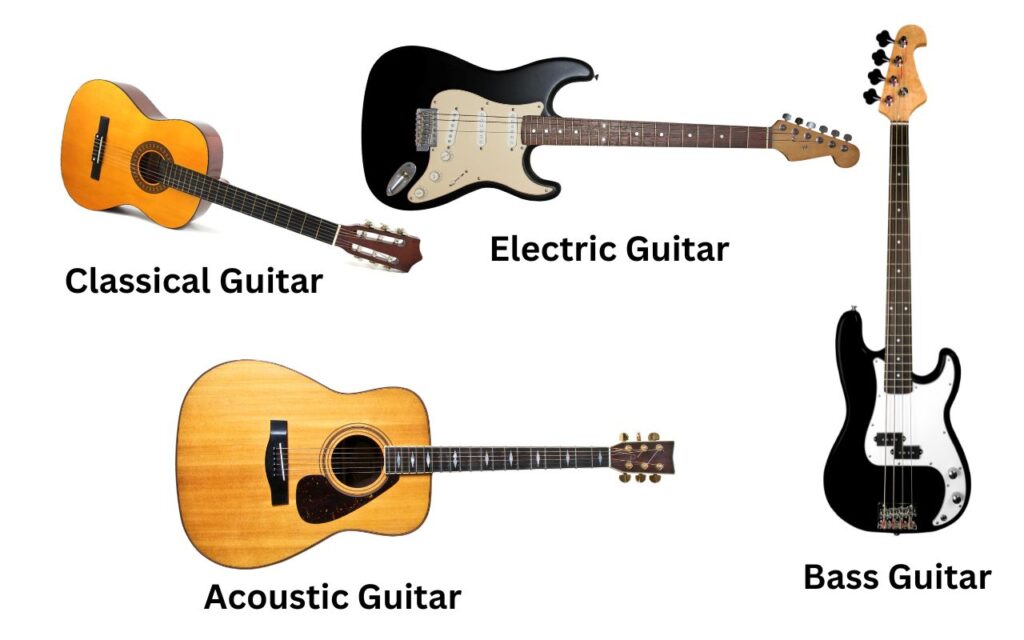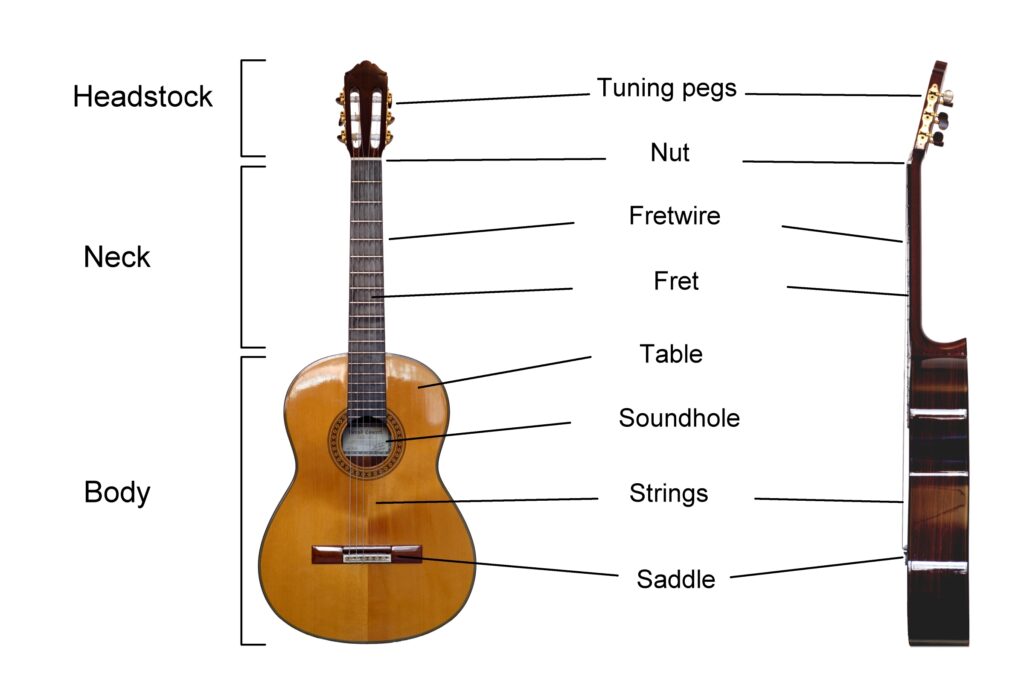Guitars are fascinating instruments that have captured the hearts of millions of people all over the world.
Have you ever wondered how a guitar works? What are the mechanisms and components involved?
How does a guitar make a sound?
In this article, we will explore the fascinating world of guitar physics and unravel the secrets of how a guitar works.
In a Hurry? Here’s a Summary of How A Guitar Works
- The body, neck, and bridge of a guitar work together to produce sound.
- When a string is plucked or strummed, it vibrates back and forth. This produces sound waves that travel through the air and then into our ears.
- The length and thickness of the string determine the pitch of the Musical note, while the tension of the string determines its volume and tone.
What is a Guitar?
Before we proceed to understand how a guitar works, we need to understand what a guitar is.
A guitar is a stringed musical instrument that has a long, thin neck with frets and a flat or slightly curved body. It typically has six strings that are stretched across the neck and body of the guitar and are tuned to different pitches to produce different notes and chords.
There are different types of guitars – Acoustic, Electric, Classical, etc.
Each type has its own special features.

If you’re interested in learning more about the types of guitars check out our blog on Different Types of Guitars.
To understand how a guitar works, it is imperative that we examine its crucial components.
Anatomy Of A Guitar
A guitar is a complex instrument that involves various mechanics working in harmony to produce beautiful music.
In this section, we’ll explore the anatomy of a guitar and the function of its different parts.
Let’s get started!
Guitar Anatomy
The guitar consists of three main parts: the headstock, neck, and body.

The headstock is located at the top of the guitar and houses the tuning pegs for each string.
The neck runs down from the headstock to the body and includes the fretboard and frets.
The body is the largest part of the guitar and contains the soundhole (or soundboard on an electric guitar), bridge, and pickups (if applicable).
“A guitar is like a woman – no two are ever the same.” – Chuck Berry
Chuck Berry may have been talking about the aesthetics of a guitar, but it’s also true that each instrument has its unique sound and feel, making it a personal choice for every player.
If you want to understand in detail the anatomy of a guitar, then check out our blog on the Anatomy Of A Guitar.
How Does A Guitar Produce Its Sound
Now that we understand the anatomy of a guitar let’s look at how it functions.
A guitar produces sound when the strings are plucked or strummed, causing vibrations that travel through the bridge, into the soundboard (on an acoustic guitar), and finally through the soundhole, creating the beautiful melodies we love.
To change the pitch of a string, the guitarist presses down on the string behind one of the frets with their left hand.
This shortens the vibrating length of the string and produces a higher pitch when the string is plucked.
By moving their fingers up and down the neck and changing the placement of their left hand, a guitarist can produce a wide range of Musical notes and chords.
In an acoustic guitar, the sound is amplified when it enters the body of the guitar through the sound hole and reflects after hitting the inner surfaces. Later it is projected out through the same sound hole and ultimately reaches our ear.
An electric guitar uses pickups that are placed under the strings to amplify its sound. These pickups convert the vibrations of the strings into electrical signals that are then sent to an amplifier, which increases the volume and tone of the sound.
So far, we’ve explored the anatomy and seen how a guitar works.
Next, we’ll dive deeper into the role played by guitar strings and the neck and bridge.
The Role Of Guitar Strings
The thickness and tension of guitar strings play a crucial role in the sound produced by the instrument.
Thicker strings tend to produce a warmer, richer sound, while thinner strings offer a brighter, more piercing tone.
Similarly, higher string tension produces a brighter sound, while lower tension creates a mellower tone.
Types of Guitar Strings Common types include:
- Steel Strings: made of steel, popular in rock, country, and blues.
- Nylon Strings: made of nylon, used in classical guitar music.
- Silk and Steel Strings: a combination of silk and steel, offering a softer sound.
- Flatwound Strings: with a flat surface, known for reduced string noise and smooth feel.
The Role Of Soundboard and Soundhole
The soundboard serves as the uppermost section of the guitar body, playing a pivotal role in enhancing and projecting the melodic resonance generated by the strings.
As the guitar strings reverberate, they dynamically convey their energy to the soundboard.
In response, the soundboard mirrors these vibrations at identical frequencies, effectively amplifying the overall volume and richness of the acoustic output, thereby contributing to a more immersive and resonant musical experience.
The Role Of Guitar Body
The Body of a Guitar is the large, curvy structure that sits comfortably on your lap as you play, or rests against your body when standing.
The guitar body isn’t just for show; it plays a fundamental role in the instrument’s sound and tone.
There are different types of guitar bodies, each with their own unique shapes and designs.
Some common types of guitar bodies include:
| Type of Guitar Body | Characteristics |
|---|---|
| Solid Body | Made from a single piece of wood, and is often associated with electric guitars and produces a loud, bright sound. |
| Hollow Body | Has a hollow chamber that produces a warmer, more resonant tone. Often associated with jazz and blues music. |
| Semi-Hollow Body | Has a center block that reduces feedback while still retaining some of the warmth and resonance of a hollow body. |
Some common materials used for guitar bodies include:
| Material | Properties |
|---|---|
| Maple | Dense and heavy, produces bright, clear tones |
| Mahogany | Warm and rich, with a balanced tone |
| Ash | Lightweight and resonant, produces bright, clear tones |
As you can see, the type of body and its material (wood) affect the sound and tone of the guitar.
The Role Of Neck and Bridge
The neck’s curvature and the bridge’s placement affect the guitar’s string action, which is the distance between the strings and the fretboard.
The wood used in the neck and fretboard can influence the guitar’s sound, as can the type of bridge used.
A solid metal bridge, for example, can produce a brighter, more resonant sound than a wooden bridge.
If you want to understand in detail what factors affect the overall sound quality of a guitar and how you can buy the best sounding guitar, then check out our blog on the 10-Factor Analysis.
Final Words
The guitar is a masterpiece of engineering, incorporating components that work harmoniously to produce sound. From strings to soundboard, body, neck, and bridge, each plays a vital role in shaping the tone.
Exploring the mechanics behind the guitar reveals its complexity.
We hope this article enhances your understanding of how a guitar works.
Whether a musician or enthusiast, we trust you now appreciate its intricacies.
So, go ahead, strum those chords, pluck those strings, and immerse yourself in a world of beautiful melodies and harmonies.
Thank you for joining us on this journey of discovery, and we look forward to seeing you again soon.
You can also read more about the important things to look for in a guitar in our comprehensive guitar-buying guide.
